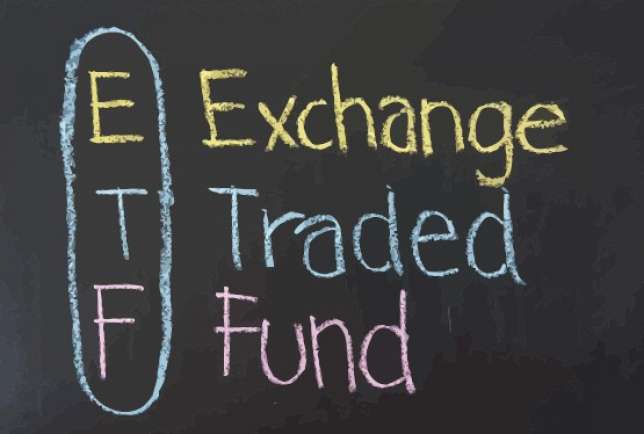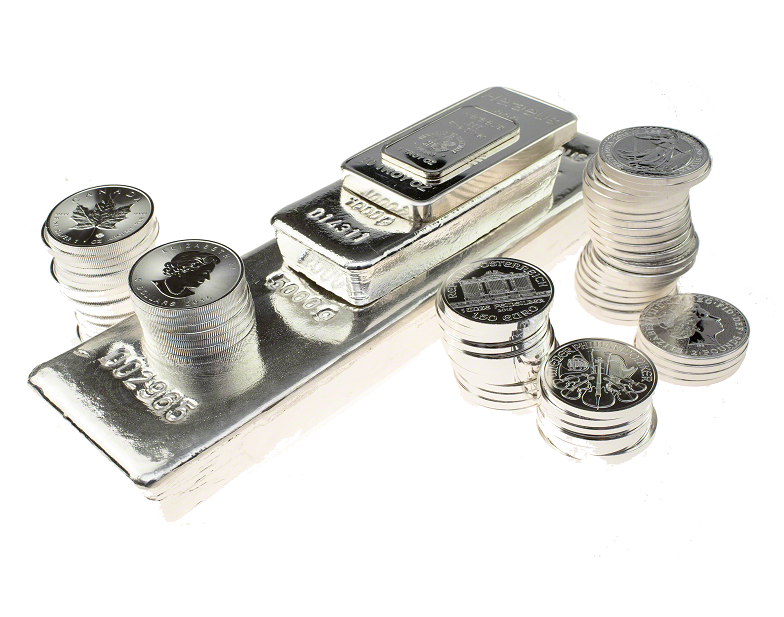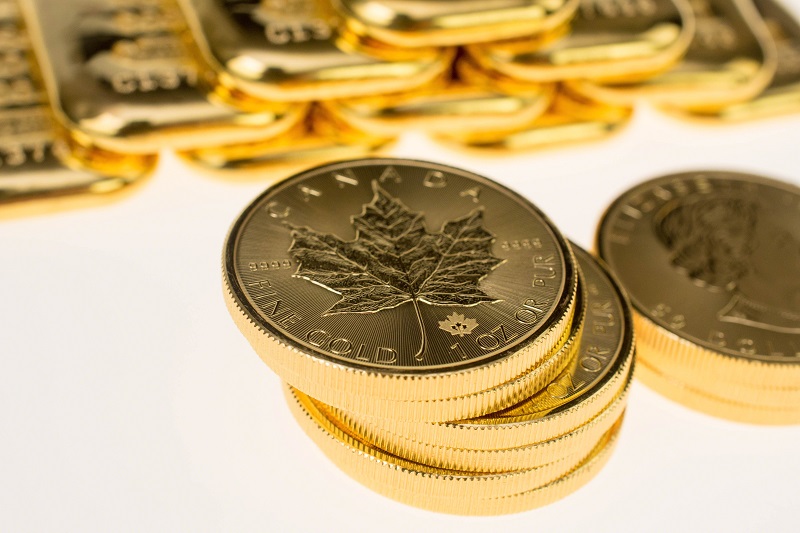Gold & Silver Bullion – Different Investment Approaches
from BullionStar:

There are a number of different ways of investing in precious metals, ranging from physical ownership of gold and silver bullion, to taking positions in derivative products which provide exposure to movements in gold prices or silver prices.
When looking at ways to invest in gold and silver, it’s important to think about which routes provide direct ownership of physical precious metals versus which routes are merely possession of ‘paper gold’ or ‘synthetic gold’ products that lack any backing of real physical metal. It’s also worth keeping in mind that while gold in physical form and silver in physical form have been universally used as money and as stores of value for thousands of years, it’s only in the last generation that gold and silver futures contracts have been traded, and even a shorter time-frame (15 years) since the first gold-backed Exchange Traded Fund (ETF) was launched.
Gold & Silver Bullion Bars and Coins
The most traditional and safest way to invest in gold and silver is in the form of high purity physical gold bullion and high purity physical silver bullion.
Bullion refers to gold bars, gold coins, silver bars and silver coins that are held for investment and saving and that are transacted and valued by weight. The term bullion therefore covers gold bullion bars and coins and silver bullion bars and coins. These bullion bars and coins are of specific gross weights, such as a troy ounce, and these bars and coins have a specific precious metal fineness, such as 0.9999 (99.99%) pure gold or 0.9999 (99.99%) pure silver.
As tangible assets, gold and silver bars and gold and silver coins share a number of common characteristics which make them ideal forms of precious metals savings and investments. Because physical gold and silver are difficult and costly to mine, they are scarce and in limited supply, and therefore physical gold and silver have inherent value. Furthermore, because gold and silver bars and coins are not issued by any government or other counterparty that could go bankrupt or default, physical gold and silver bullion do not have any counterparty risk or default risk.
It’s precisely because physical gold has inherent value and lack of counterparty and default risk that the world’s central banks hold large quantities of gold in vault storage typically in the form of 400 oz gold bars.
In Singapore, high purity gold and silver bullion bars and coins are defined as Investment Precious Metals (IPM), and are exempt from Singapore’s Goods and Services Tax (GST). This means that when you buy investment precious metals for storage, delivery or possession from a bullion dealer in Singapore such as BullionStar, you do not have to pay any GST on the transaction.
Investment-grade gold and silver bullion bars are fabricated by leading precious metals refineries and mints around the world such as Argor-Heraeus and PAMP in Switzerland, and Heraeus in Germany. These bars have high gold and silver purities, for example, 0.9999 fine gold and 0.999 fine silver.
It is good practice to purchase gold and silver bar brands produced by refiners that are listed on the London Bullion Market Association (LBMA) Good Delivery List for gold and silver as these lists reflect refineries which have the highest operating and technical standards. Beside, only bars from these LBMA refiners are exempt from GST in Singapore. Gold bars and silver bars from these refineries will almost always have the refinery stamp and weight and purity of the bullion bar stamped on them and will often have unique serial numbers. Popular sizes for gold bars are the 1 kilogram and 100 gram gold bars, and popular sizes for silver bars are the 100 oz silver bars and 1 kilogram silver bars.
Investment-grade gold and silver bullion coins refer to precious metals coins of specific weight and high purity metal fineness that are fabricated and minted by the world’s leading precious metals mints. These mints include the US Mint, Royal Canadian Mint, Perth Mint, Royal Mint and Austrian Mint.
Bullion coins from these mints are issued in a variety of weights, one of the most common being the 1 troy ounce weight. Bullion coins will be distinguished by their designs and names and with such well known coins as US Mint Eagles, Royal Canadian Mint Maple Leafs, and Perth Mint Kangaroos. Bullion coins from these Mints will normally be issued each year, and will have the year of issue specified on the coin, along with the coin’s weight and metal fineness.
One of the fundamental benefits of investment precious metals is that when you buy gold or silver bullion bars or coins, you become the real beneficial owner of that precious metal. You can then either take delivery of the bars and coins and store them at home or in a safe deposit box, or alternatively, you can store your gold and silver in vault storage where a custodian guards and protects the bars and coins for you in secure allocated storage.
Allocated precious metals storage means that the custodian will store your exact metal for you and the holding is not just a claim on the custodian to provide an equivalent amount of metal. It’s important to use a secure storage provider that is independent and that resides outside the banking system, and to ensure that your precious metals bars and coins are insured and can be physically audited. BullionStar’s secure vault storage service is an end-to-end solution for buying, selling and storing bullion where you have full online control of your vaulted bullion at all times 24/7.
Exchange Traded Funds
Exchange traded products backed by gold or silver are a relatively recent addition to the range of gold and silver related investment options on the market. Generically known as Exchange Traded Funds (ETFs), these metal-backed investment vehicles which have only been around since the early 2000s, refer to trusts, funds, or other legal entities which hold gold or silver bars with a custodian in a vault, and which then issue units, securities or shares reflecting undivided fractional ownership in that trust or fund. Buyers of these ETFs then essentially buy and hold units or shares within the trust or fund. Examples of such products are the SPDR Gold Trust and the iShares Gold Trust.
These ETFs are designed to track the international price of gold or silver, and they provide the unit holder with exposure to the price of gold or the price of silver, not to an actual holding of physical gold or physical silver. The ETFs do not claim otherwise, and taking gold-backed ETFs as an example, they state that their shares or units are designed to, for example, “reflect the price of gold bullion” or to “provide the performance of the spot gold price”, with the unit holder having “no beneficial ownership to gold”. Therefore, these products do not provide their holders with direct ownership of physical gold or silver. Rather, the holder of the ETF is a shareholder, not a gold holder. For an infographic on Gold ETF Mechanics, see here.

Once an investor holds units of the ETF, the units then move in price, attempting to mimic the price movements of the underlying precious metal. While the units reflect effective fractional ownership in a trust or fund, they don’t provide any entitlement to the actual gold or silver held by the ETF, and holders of ETF units cannot convert their units into physical gold or silver, or take delivery of the underlying gold or silver.
In addition, as the underlying metal is held in large 400 oz gold bars or large 1000 oz silver bars, the underlying metal is not even sub-dividable into smaller quantities. The metal is essentially held in a pool, and even though it’s allocated to the trust or fund, it is not allocated to any of the unit holders either jointly or separately.
Another drawback of these ETFs is that they are not transparent, with the gold and silver bars underlying the trusts held in secretive gold vaults, mostly in London and New York, the vault locations of which are never published. It’s also not normally possible for any ETF holder, not even for large institutional holders, to visit these vaults to verify the existence of the underlying metal, let alone to conduct any independent gold audits of the metals claimed to be held.
Precious metals backed ETFs have complex structures with a lot of moving parts, complex prospectuses, and a wide array of participating entities such as trustees, marketing agents, custodians, Authorised Participants (APs), and issuers. And ETFs also need to be traded through a brokerage account. All of this adds up to potentially significant counterparty risk for the ETF unit holders.
The annual and quarterly fees to all the involved participants in an ETF also eat into the effective entitlement of each unit in an ETF, since these products accrue expenses and then regularly sell off small amounts of gold or silver held in the trust or fund to pay the fees. For example, when the SPDR Gold Trust (GLD) was launched in late 2004, each GLD unit was worth 0.1 ounce of gold. But due to fees and expenses since then, that same GLD unit is now worth 5% less, and now only represents about 0.095 ounces of gold per unit.
While precious metals backed ETFs will provide exposure to the international gold or silver price, they have very limited track records since they have been in existence for 15 years or less and have never been tested in a severe systemic financial crisis during which one of the participants in the chain of entities that make up these products could go bankrupt or cease to exist.
Some other price tracking ETFs marketed as gold or silver ETFs have an even weaker connection to physical metal, and are not even backed by precious metals. Those products merely invest in futures and options which track the gold or silver price. Such ETFs merit even more due diligence for the prospective buyer.
Gold Mining Stocks
Buying shares of gold and silver mining companies on the stock market is another route for gaining exposure to gold and silver prices, the logic being that if gold or silver prices rise, then the mining company’s revenue will also rise and thus benefit the company’s stock price. These mining stocks can be in either the precious metals exploration sector, the integrated mine exploration and development sector, or shares in precious metals royalty streaming companies.
Loading...




